Urbanmotion
What the World needs now isn't love, sweet love, (sorry Dionne Warwick), it's a new take on what 'the car' is.
The future of personal transport isn't ever-bigger vehicles, that is becoming quite obvious. The graph showing the average cubic-metreage of cars has reached the peak of its bell-curve and we're now on a steady slope to impossibly small cars. Range Rover Vogues and Jaguar XJs look out of place on our little British roads, although fit in quite nicely on the USA's hefty highways. Not everyone has ten million square kilometres of room to fit a spaghetti of ten-lane tarmac every which way. In fact the UK has only 1/40th the space of our stateside chums but we have to fit 1/5th of their population into that.
Britain is screaming out for smaller cars!
First let me come clean and say I'm not helping matters. My car is 18ft long and 7ft (and some change) wide. It is a behemoth. I'll leave it up to you to decide if I genuinely do like the exceptional ride comfort you get with a big car with massive wheels to absorb the bumps, or if I'm merely compensating for being hung like a wasp.
That's an important thing to note: if we're going smaller, we can't sacrifice ride quality.
The next thing we shouldn't sacrifice is the ability to look cool. Do you think bankers and dentists are going to give up their Porsche 911s for an electric milkfloat? Of course they won't. How would they attract the girls they cheat on their wives with driving something that whirrs into the Premier Inn car park instead of growls?
Nissan's Got It Wrong
The Nissan Leaf is a laudable evolution in motoring. Nissan have truly beaten everyone else to market an affordable, reasonably practical and unexpectedly great-performing electric car. But it's wrong from the offset. The Nissan Leaf is Betamax. It is Laserdisc. The Nissan Leaf is a throw-away project that will not be with us for very long and thus suffer from catastrophic depreciation. Why? Because of one simple little word in its marketing literature:
Batteries.
To coin a phrase, I can't believe it's got batteries. Everyone knows that batteries don't work. Laptops, smartphones, travel alarm clocks, digital cameras, Nintendo Gameboys, they all rely on batteries and therefore are impossible to rely on. They are going to let you down at the most inopportune moment. Fact.
Nissan should have gone the way of the Honda FCX Clarity, a hydrogen-fuel-cell powered vehicle that operates similar to today's fossil-fueled ones. You have a tank of fuel, in this case hydrogen, and you consume the fuel to produce power and then when you've exhausted your fuel you stop at a hydrogen pump and top it up again. No 10-hour waits while your batteries are re-energised. And no unnecessary lugging around the weight of a fat passenger in Lithium-ion cells everywhere you go.
Hydrogen power is the future. But beware of the oil companies hampering that progress from happening. (If they only stopped thinking about oil and their bottom lines and started realising that the first company to make hydrogen fill-ups commonplace and easy will reap even bigger rewards while making the world a better place to live...)
The Car of the Future
Here's my vision of the car of the future. It needs to be thinner than cars today. This means that every two lane road can be converted into a three-lane one offering 50% more capacity. This may require some drastic changes to their shape. You only need to look as far as the incredibly cute Toyota iQ, already on our roads, to see what I mean:
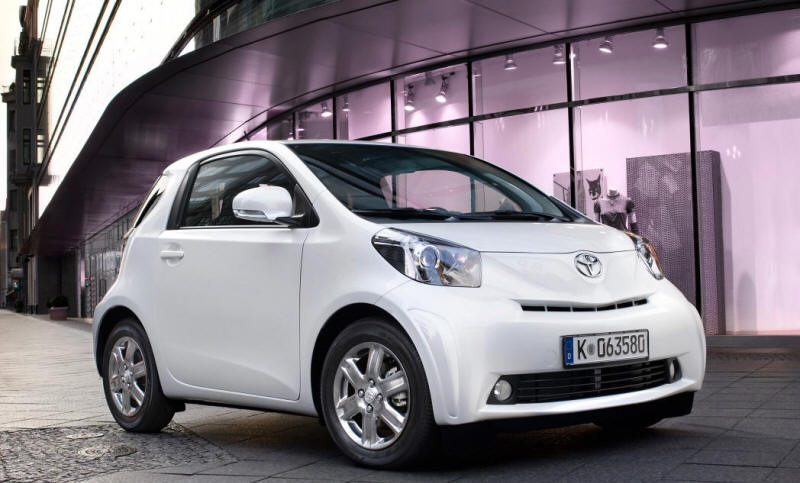
It's a washing machine with piddly wheels yet I'm a very vocal fan of the iQ. I love that face, it looks like it is smiling wherever it goes. It is a weird shape, but it is adorable.
Now imagine that with only one seat...
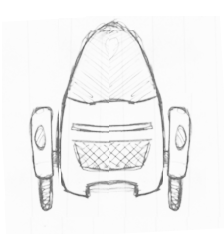
Weird, eh. It's so small it will only need a tiny amount of power to make it go anywhere. Those "road bike" wheels/tyres reduce rolling resistance to an absolute minimum and some clever suspension stuff inside the body can keep the ride comfort to levels we are accustomed to.
Why go thinner? Well, cars travel forwards most of the time, so we tend to keep our distance from the car in front, but are quite happy to sit for hours at 70mph only a couple of feet from the car alongside us. This means that the way to unlock the potential of the road is expand its use width-ways. This is the same as bandwidth vs. throughput if you're a networking nerd.
And cars should be modular. Commuting tends to be a single-person task (seriously, count the people in the cars around you when you're next stuck in a jam on the way to work!), so cars should be single-person transports for the most frequent journeys which are to work and back. At the weekend, if you want your loved one to come along on a trip then you can simply plug in an extra seating module in tandem and away you go.

Some company with enormous amounts of R&D, Porsche for example, could probably make the in-line, single-seater car look pretty snazzy too.
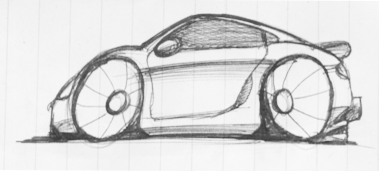
The Recipe
Car makers take heed. This is the recipe for the car of the future:
- Hydrogen powered
- Small
- In-line not 2+2, meaning we can expand the entire road network simply by painting new lines instead of roadworks
- Skinny tyres to reduce rolling resistance
- Ride comfort must not be impaired
- Modular design to make sure that you only carry the weight you need to
God Bless Audi
Naturally, those Ingolstadt-dwellers, Audi AG, have been reading my sketchbook again.
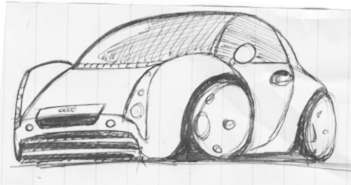
This is something my pencil dribbled onto some parchment some months ago (it doesn't conform to The Recipe above because that came later and has developed somewhat since the sketch). It is a single-seater (note the size of the door handle for a bit of scale), in-line vehicle. The positions of the bonnet and windscreen should allow for good EuroNCAP scores for pedestrians and passengers, while the lights should be in the right place to conform to UK regulations on that type of thing.
Audi are going to be showing this at the Frankfurt Motor Show in September:
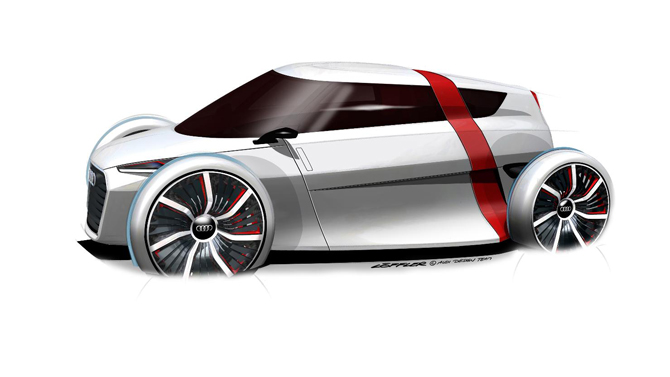
It is a small, electric (batteries again though, ho-hum...), lightweight car with thin wheels. Interestingly it isn't inline like I think cars will end up being, instead it uses staggered seating.
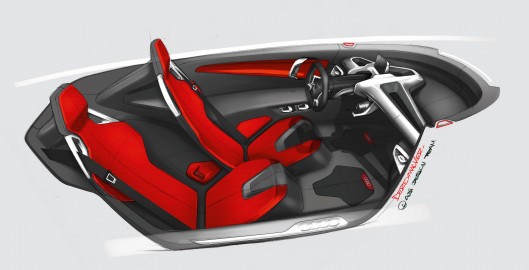
I really like that. It looks like two-thirds of a McLaren F1 and as everyone except Rowan Atkinson knows, McLaren F1s are awesome.
UPDATE 29/08/2011:
Audi have released new pictures and details about its Urban Concept vehicle:
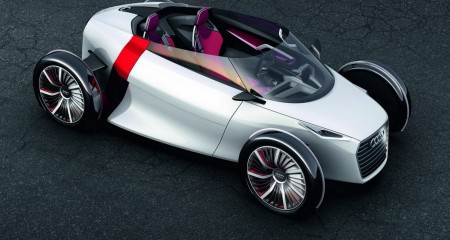
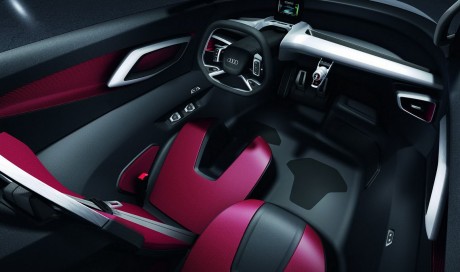
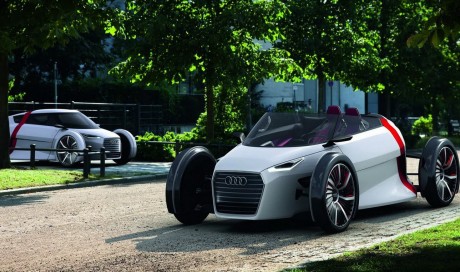
Comments...